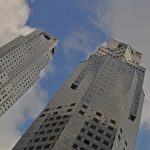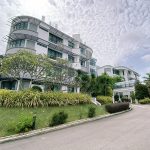CapitaLand Mall Trust secures its first sustainability-linked loan of S$200 million from UOB
CapitaLand Mall Trust Management Limited (CMTML), the manager of CapitaLand Mall Trust (CMT), and United Overseas Bank Limited (UOB) on 8 September announced that UOB has converted a S$200 million revolving credit facility extended to CapitaLand Mall Trust into a sustainability-linked loan.
This is CMT’s first sustainability-linked loan, of which proceeds will be used for general corporate purposes. UOB also acted as the sustainability agent and coordinator for this transaction. A sustainability agent and coordinator works closely with clients to help measure, improve and maintain their sustainability performance.
Under the terms of the sustainability-linked loan, UOB will offer CapitaLand Mall Trust tiered interest rates on the facility based on CMT’s achievements in the annual GRESB Real Estate assessment. GRESB is a leading environmental, social and governance (ESG) benchmark for real estate and infrastructure companies’ ESG efforts in management, environmental performance and building development.

The GRESB Rating is based on the GRESB Score and its quintile position relative to all participants in the GRESB Assessment, with annual calibration of the model. If the entity is placed in the top quintile, it will be a GRESB 5 Star rated entity; if it ranks in the bottom quintile, it will be a GRESB 1 Star rated entity, etc. As the GRESB Rating is calculated relative to the global performance of reporting entities, it shows you exactly where an entity stand on a global scale. GRESB 5 Stars is the highest rating and recognition for being an industry leader. Each year, 20% of entities receive a GRESB 5 Star rating.
CapitaLand Mall Trust was recognised as the leader in the Asia “Retail – Listed” category in GRESB 2019.
Mr Tony Tan, CEO of CMTML, said: “The sustainability-linked loan from UOB marks another milestone in CMT’s journey to continually strengthen our ESG standards while creating long-term value for our stakeholders. It follows CMT’s first S$200 million green loan secured on 1 October 2019 to finance the Building and Construction Authority Green Mark-certified properties in our portfolio. CapitaLand Mall Trust is firmly committed to sustainability and we are pleased to be able to capitalise on our ESG achievements to enhance our financial position, especially during these uncertain times.”
Mr Leong Yung Chee, Head of Corporate Banking Singapore, UOB, said: “At UOB, we are committed to collaborating with our clients to advocate sustainable development. This sustainability-linked loan demonstrates how UOB and CapitaLand Mall Trust are working together to drive responsible growth for the benefit of our community. It also builds on our efforts to help more companies in Singapore improve their ESG impact through the use of sustainable financing solutions.”
CapitaLand Mall Trust is the largest retail real estate investment trust in Singapore by market capitalisation. In addition to GRESB, CapitaLand Mall Trust is included in several indices, including the FTSE4Good Index Series (FTSE4Good), iEdge SG ESG Indices, FTSE EPRA Nareit Global Real Estate Index Series and FTSE Straits Times Index.
About Sustainability-Linked Loans
Sustainability linked loans aim to facilitate and support environmentally and socially sustainable economic activity and growth. The Sustainability Linked Loan Principles (SLLP) have been developed by an experienced working party, consisting of representatives from leading financial institutions active in the global syndicated loan markets.
The goal of the SLLP is to promote the development and preserve the integrity of the sustainability linked loan product by providing guidelines which capture the fundamental characteristics of these loans. In doing so, the purpose of the SLLP is also to promote sustainable development more generally. The SLLP are voluntary recommended guidelines, to be applied by market participants on a deal-by-deal basis depending on the underlying characteristics of the transaction. The sustainability linked loan product enables lenders to incentivise the sustainability performance of the borrower.
The SLLP are intended for broad use by the market, providing a framework within which the flexibility of the loan product can be maintained, and will be reviewed on a regular basis in light of the development and growth of sustainability linked loans.
Sustainability linked loans are any types of loan instruments and/or contingent facilities (such as bonding lines, guarantee lines or letters of credit) which incentivise the borrower’s achievement of ambitious, predetermined sustainability performance objectives.
The borrower’s sustainability performance is measured using sustainability performance targets (SPTs), as set against key performance indicators, external ratings and/or equivalent metrics and which measure improvements in the borrower’s sustainability profile.
The use of proceeds in relation to a sustainability linked loan is not a determinant in its categorisation and, in most instances, sustainability linked loans will be used for general corporate purposes. Instead of determining specific uses of proceeds, sustainability linked loans look to improve the borrower’s sustainability profile by aligning loan terms to the borrower’s performance against the relevant predetermined SPTs.
For example, sustainability linked loans will often align the borrower’s performance to margin redetermination over the life of the sustainability linked loan. In some instances, a loan may be structured to allow for its categorisation as both a green loan, aligned with the Green Loan Principles, and a sustainability linked loan.
Sustainability Linked Loan Principles – Core Components
The SLLP set out a framework, enabling all market participants to clearly understand the characteristics of a sustainability linked loan, based around the following four core components:
- Relationship to Borrower’s Overall Sustainability Strategy
- Target Setting – Measuring the Sustainability of the Borrower
- Reporting
- Review






